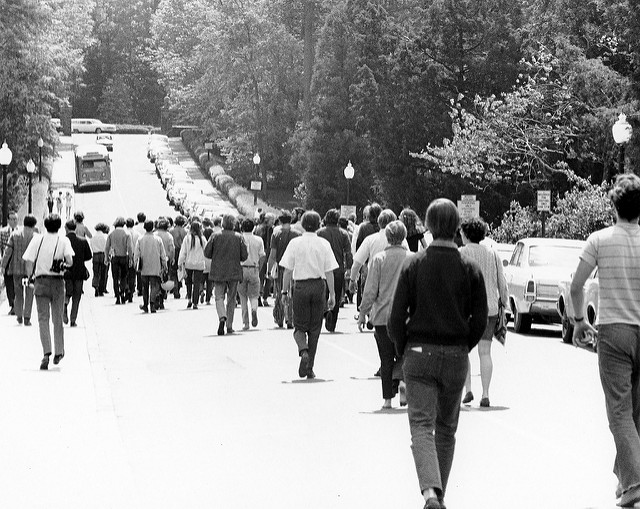After looking back at two notable student movements in recent history in my last two pieces: The Affordability of Education and Campus Unrest Part 1, I want to conduct a thought experiment: How might different aspects of being a student influence one (or many) to take on the role of an activist? How do the identities of “student” and “activist” reinforce one another, and how do they conflict?
Being a Student
I hope to avoid the bias of making over-generalized claims about college students. I came up with five commonalities. This is not to assume that all of these apply to all students, but here are some general trends that I have observed in myself and peers over my seven years as a college student:
I) Intellectual Growth—Students are engaged in academic learning
In theory, the point of higher education should be to voluntarily pursue an area of interest for focused study. To what extent people entering college are actually enthusiastic and engaged in academics is highly variable. But if you’re in school to learn, then you are striving overall toward intellectual growth and self-improvement.
II) Exercise in Agency—Being a student is an attempt to decide your own future
Another reason students are in college is preparation for a future career, or life goal. When we enter college, the hope is that by the time we leave we will be better off. A reason why students might be in classes they are not intellectually interested in is those classes are for requisite or qualification for a long-term investment in a degree, or career. In this way, being a student is a way of taking charge of your own social mobility.
III) Financial Investment / Restriction—Students pay for their education, and/or are on a fixed amount of financial aid
College costs money. Just as a student is investing time in taking courses, so too are they investing their capital. Paying for courses at a school is a monetary investment in that particular institution. Financial aid is not accessible to everyone, but, for those that qualify, aid often requires a specific amount of credits per semester and that aid runs out after a set amount of time. Wherever the money comes from, schools generate revenue from students, and students are striving for a return on their investment.
IV) Ephemeral Status—Education has a foreseeable endpoint: completion of a degree
Typically, students are only students for a fixed time. Degrees have a set number of credits, and once completed, an individual moves on and no longer holds the status of student. Though it may seem very far away for some of us, or right around the corner, there is a “light at the end of the tunnel”—there is a point in the future in when we imagine ourselves no longer taking courses.
V) Collaborative Exchange of Ideas—Students interact with peers and instructors in both academic and social spaces
Being a student requires having a teacher. It requires a conversation and an exchange of ideas to pass on knowledge or spark creativity. Often the ratio is multiple students per one instructor, and peer-to-peer interaction may be part of the coursework, or it can manifest organically as a byproduct of being “in the same boat.” This can take the shape of either camaraderie or agonism; but ultimately individuals are put in direct social connection, which sometimes creates a community (though not necessarily a cohesive one).
The Shape of Activism
The specific ways in which activism can manifest, or rather what exactly one is “active about” can take many forms for students. Some examples include, but are not limited to:
- student governments (elected to control student budgets)
- public interest research groups (advocating for socioeconomic issues)
- national political parties (democrat, republican, socialist)
- community service volunteer activities (soup kitchen, park clean-up, food drive)
- groups organized around specific issues (abortion, gun control, immigration)
- resistance to the status quo (college policy reform, sit-ins, strikes)
- community/civic engagement (voter registration, community garden, citizen outreach)
- well-being of others (peer counseling, mentoring, big buddy, safe-spaces)
- common interest clubs/organizations (cultural, environmental, competitive team, recreational)
These are all different, perhaps overlapping end-products of student activism that we can observe, but what I really want to analyze is how students get there. Which aspects of the ”student condition” reinforce activism, and which aspects stifle it?
The Student Condition:

Reinforcing Activism
Being receptive and intrigued by new ideas (I), and engaging in critical thought (V) around these ideas should be conditions that promote activism. If students consider their education as a financial investment in their future and an opportunity for social mobility (II, III) they are learning to care about the future, and are engaged in changing their own lives. These two factors set the stage for students to be more attentive to where they invest their time and money, and the larger scope of where their energies go ultimately in society. To approach being a student as an active investment in one’s future (II) may further promote activism through thinking about professional development for a resume or extra-curricular. Finally, as a student in active dialogue and discussion with others in the institution (V), there may arise a perception of “campus as community”—and along with this the belief that an individual and the students around them are a unit of influence and the recognition of the college as a space of demonstration and activity.
Inhibiting Activism
The very nature of being a committed student requires a significant investment of time in academic study. College can be a balancing act between coursework to maintain a GPA and supporting oneself with a job (I, III). With only so many hours in the day, time management challenges, and limited personal resources, security can be the largest hinderance on the ability of a student to engage in activist practices (though for some these restrictions rouse the impetus to actively change these conditions). Being a student is a temporary identity, with a finite endpoint (IV) and some find this condition justification enough to not invest oneself in opportunities at college outside of classes. Those who do become student activists inevitably graduate, and the continuation of the movements that they participate in hinge not only on the work of these students during their matriculation, but that their work inspires future generations of students to carry the torch with each successive cohort. Finally, some students may approach college with a rigid focus on a set formula for their career. Advisement given to students may limit them to a set checklist, with traditional pathways. Students that perceive this defined path may view activist movements as tangential investments of their energy, and a distraction from what they “need” to do within their time and monetary constraints (I, II, IV).
The Purpose of Student Activism
Within the model outlined above, we can see that the same factors that promote activism may also discourage students. I listed some tangible forms that activism can take, but now given the above analyses, here are three overarching ways in which I believe the reinforcement of student activism can outweigh the inhibition of it:

Credit: Vinnie Bezoomy/Flickr
1) Activism can be an opportunity. Being a part of an activist movement or civic/community institution can align with career goals, degree requisites, or bolster resumes. Though this incentive can begin selfish in its inception, taking on the role of activist can change a student’s mindset and approach to life. By learning through experience and exposure there is the opportunity to incorporate the attitudes and modes of activism into the way an individual lives.

Credit: Duke University Archives/Flickr
2) Activism can be for a communal benefit. If students view themselves as a part of a larger and cohesive community of like-minded individuals, it may set a foundation for students to join together to demand access to a right or privilege. With a strong sense of unity and combined agency, students may engage critically in movements to enact change or restructure power dynamics. Through this students can approach and incite action and awareness with regard to equality and equity for groups of individuals.

Credit: Marquette University/Flickr
3) Activism can arise out of necessity. Typically a student is living with constraints and pressures—be they economic, spacial, temporal, cultural, or otherwise—and through these shared obstacles, students can find common cause to push back against their limitations. (For one concrete example discussed in my first article, affordability can have a breaking point, even for the academic institution itself.) When this happens the academic institution becomes a nexus for individuals to express shared experience and resist oppression and fight for change together, through a common need.


